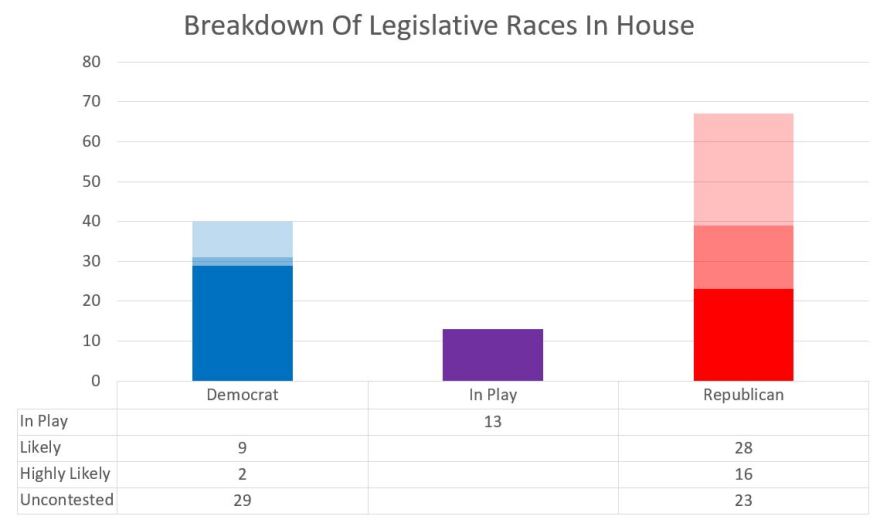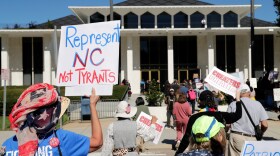Even if Roy Cooper takes up residence in the executive mansion, Democrats face a tough challenge in the General Assembly to break a veto-proof majority that Republicans hold in both legislative chambers.
Analyzing General Assembly races across North Carolina shows it all but impossible for Democrats to achieve a majority in either chamber. Furthermore, taking a supermajority away from Republicans in either chamber will present a tall order.
An analysis of 2014 election results, district demographics, and campaign finance, shows that it will be very hard for Democrats to make significant gains in the General Assembly.
“It’s very difficult,” said Thomas Carsey, a UNC-Chapel Hill professor of Political Science. “There are so many districts that are drawn to be pretty safe for the Republican Party that it’s going to be difficult for the Democratic Party to pick up enough new seats to do much of anything in the state legislature. They may pick up some seats, but they may not even get past a veto override majority.”
In the North Carolina General Assembly, there are 120 seats in the House of Representatives, and 50 seats in the Senate. In order to override a governor’s veto, each chamber must reach a three-fifths majority: 72 votes in the House and 30 votes in the Senate.
Related: Federal Appeals Court Strikes Down Wake Co. Redistricting Maps
Although the gubernatorial race between Republican incumbent Pat McCrory and Attorney General Roy Cooper has so far polled too close to call, it’s a safe bet that if Cooper wins, he will wield a regular veto stamp.
After landslide Republican victories across the state since 2010, the GOP has enjoyed override power in the legislature. That strength was flexed far more often while a Democrat – Beverly Perdue – was the governor, but even under Pat McCrory, legislators made their power known.

In the 2011-12 biennium, Perdue vetoed 19 bills, of which 11 were overridden. In his four years, McCrory has vetoed six bills, of which four were overridden. In the 2015-16 legislative session, Republicans held 74 House and 34 Senate seats.
To analyze races in the upcoming contest, WUNC looked at previous contests as well as voter statistics. The most weight was given to the 2014 election. If the winning candidate took at least 60 percent of the vote, WUNC considered that district “very likely” to go to the same party. If the winning candidate took 55 percent, WUNC considered that contest “likely” to go in the same direction.
Using this basis for analysis shows the Democratic Party faces a tall order to reach 21 seats in the Senate, the number of seats needed to take away a supermajority from Republicans. Based on previous results, there are seven Senate races considered “in play,” but Republicans currently hold six of those seats. That means Democrats would have to hold the current seat in play and flip five of the six “in play” races in which a Republican is the incumbent.

The House presents Democrats with a better opportunity for victories. Based on previous results, there are 13 races in play, though political strategists guess the number of vulnerable seats a few higher in part because presidential election years tend to draw a higher percentage of Democrats.

“The barriers to voting tend to be higher for people with lower incomes, lower educations, less access to the polling places, and those groups tend to be more proportionally Democratic,” said Carsey, who expected Democrats to post a higher voter turnout this year than in 2014.
“We would expect that the Democrats would make some gains … coming off an extremely bad year for them two years ago,” said David Rohde, a Duke University professor of political science. “But how much?”
Although the projections favor Republicans, N.C. Republican Party Executive Director Dallas Woodhouse hasn’t taken anything for granted. “The fact that many of these house races may favor us, does not mean we don’t have to spend time, effort and resources to retain those seats,” he said. “We have to work to keep all those where we have a Democratic, unaffiliated or Libertarian opponent.”
He pointed out that House districts tend to be more “volatile” and estimated closer to 20 races that are in play, with the majority of competitive races in Wake and Mecklenburg counties.
“We are very confident that we will get the seats we need to end the Republican supermajority in the house, and bring some balance back to North Carolina politics,” said Grier Martin, a Wake County Democrat in the N.C. House. “When Republicans drew the districts, part of their goal was to maximize the number of Republican seats, and they did a good job with that. But that meant that they left some of their incumbent Republicans without enough of a buffer to sustain a determined Democratic opponent.”

In addition, some historically strong Republican districts in Charlotte could be vulnerable based on the brouhaha over House Bill 2, which the General Assembly passed in an effort to block a Charlotte city ordinance that allowed people to use the bathroom of their gender identity.
“Having large majorities means we have lots to defend, but we are up to the task,” said Woodhouse.
Underlying all races in North Carolina is the matter of redistricting. After the 2010 Census, state legislatures across the nation redrew district maps, including North Carolina where Republicans enjoyed a majority in the General Assembly for the first time in decades. The new maps proved beneficial to subsequent elections. Despite having never controlled more than seven Congressional seats before the new maps, Republicans reached nine seats in 2012 and 10 of 13 North Carolina Congressional seats in 2014. North Carolina has 2.7 million registered Democrats, some 30 percent more than registered Republicans. As of Oct. 1, the state had 2.7 million registered Democrats, 2 million registered Republicans and 2 million registered as Unaffiliated.
The new maps affected statehouse races as well, and groups brought a legal challenge against the districts claiming they were racially gerrymandered. In August a federal court agreed with that claim, ruling in part that, “race was the predominant factor motivating the drawing of all challenged districts.”

The General Assembly must redraw the district maps, though the 2016 election will operate under the existing gerrymandered map as the court ruled there was not enough time between its ruling and Election Day.
Gerrymandered districts has also led to a high percentage of uncontested races. Republicans have 40 races in which they do not face a competitor, while Democrats have 35 such races. In both the House and Senate, there are more uncontested races in North Carolina than the national average, according to Ballotpedia.
This is the first of three stories on North Carolina elections. Check back tomorrow for a feature on legislative rematches from 2014.











